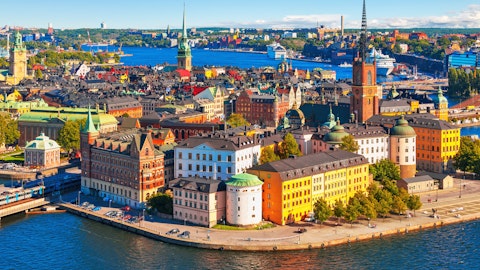Aleksander Peterc: Great. Yes. So I’d just like to come back a little bit on margins again following up on Andrew’s question earlier. So, can you give us a sense of whether margins will bottom out in the first quarter of the year, that 40% to 42% range or should we model broadly speaking, a similar range for the second quarter because you said these pressures will persist and then we’ll see an improvement. And then just broadly speaking, do you think that networks can longer term return to a 44% to 46% gross margin range, which you saw in previous quarters towards that an artificially high level of gross margins as a result of a particularly favorable business mix, which is not expected to prove the longer term just in broad terms. Thank you very much.
Carl Mellander: Yes, I can start on that. It’s — as we have said, it’s — the first half is really where we’ll see the sizable inventory adjustments that impacting primarily from runner markets and their front runner markets around the world. So, we think that those effects are going to be there for the first two quarters. And from there, you’ll start to see an improved market environment during the second part. And the reason why we believe the market will improve is actually the underlying traffic growth. So that gives us the comfort. And this is what we’ve seen, by the way, previous swings you’ve had in CapEx. So, when you’ve had those big adjustments, operators can sweat assets for a couple of quarters, but it cannot be done for much more because simply traffic grows fast underneath. So that’s why we’re — what we are seeing is a gradual improvement in the second part of the year. So that’s the way we try to model it.
Aleksander Peterc: Thank you very much. And just a quick follow-up.
Peter Nyquist: Yes.
Aleksander Peterc: Yes. Can I just ask you — can you give us an annual run rate of IPR and our quarterly run rate now that your main deals have been renegotiated? Could you provide us with an estimate at this stage? Thank you.
Carl Mellander: Yes. So, current portfolio is around SEK9 billion. As you know, we ended up with 10.4% now during 2022. What we have also said, as you know, and we expanded on that at the Capital Markets Day is that we expect IPR to grow significantly. There are more device players in the ecosystem that are currently unlicensed, especially for 5G. So, we’re targeting those now on the back of the large agreements that we have just signed. But there’s also other growth opportunity there, consumer electronics, IoT, as we have mentioned before. So, we believe that we cannot talk exactly about the timing because this is about negotiations, obviously, with the licensees, but we expect it to grow over time.
Peter Nyquist: Thanks Carl.
Aleksander Peterc: Thank you very much.
Peter Nyquist: Thank you, Aleksander. So we are now ready to go further in the Q&A queue. So, the next question I have here is from Andreas Joelsson at Danske. Hi, Andreas.
Andreas Joelsson: Hi and good morning. A question on Vonage, please. If you could elaborate a little bit how the business model is actually working. Is it a subscription-based model? Is it a license-based models for getting sort of access to the APIs? Or how does that work really? Thanks.





